Abstract
1. The upper limbs of normal subjects were immobilized in a way that allowed measurement of forces and movements at the thumb interphalangeal joint without significant movement elsewhere in the limb. 2. When the subject attempted to maintain a steady flexing force at the joint against a rigid stop, the actual force showed the irregular 8-11 Hz fluctuations characteristic of a 'physiological tremor'. This force fluctuation increased when the mean flexing force increased. 3. If the subject exerted his flexing force against a light complaint spring, there was an analogous irregular 8-11 Hz movement at the joint. 4. When, however, an extra inertial load was added to the terminal phalanx, flexion against a complaint spring was often accompanied by a different type of tremor. This was a more regular oscillation, of lower frequency (3-6 Hz), and of much larger amplitude. 5. The precise frequency and amplitude of this type of tremor depended on the characteristics of the added inertia and spring, in a way that could have been predicted from the responses of the joint to an imposed sinusoidal movement (Brown, Rack & Ross, 1982a). The movement appeared to arise from re-excitation within stretch reflex pathways. 6. The irregular 8-11 Hz tremor at this joint could not be attributed to reflex re-excitation, since the responses to sinusoidal movement indicated a stretch reflex whose timing would not support a movement at that frequency. It is, however, emphasized that other joints of the hand and fingers may behave in different ways.
Full text
PDF
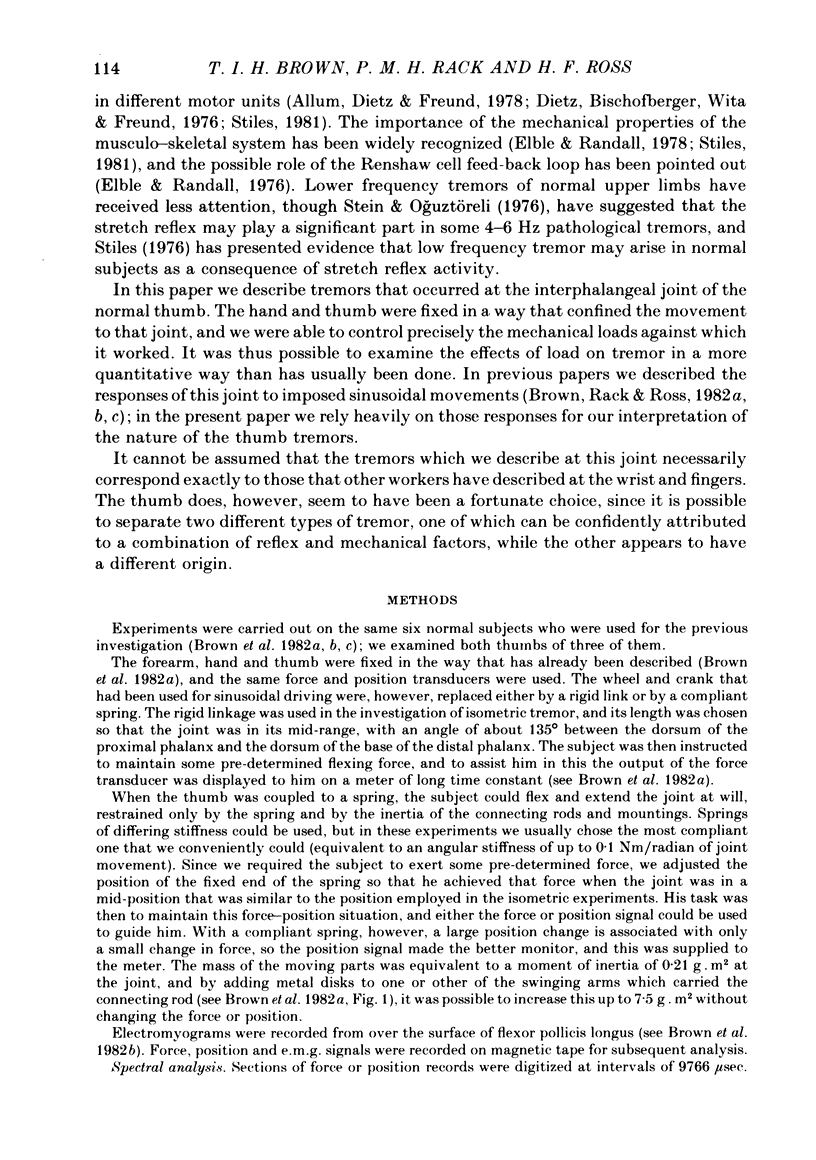




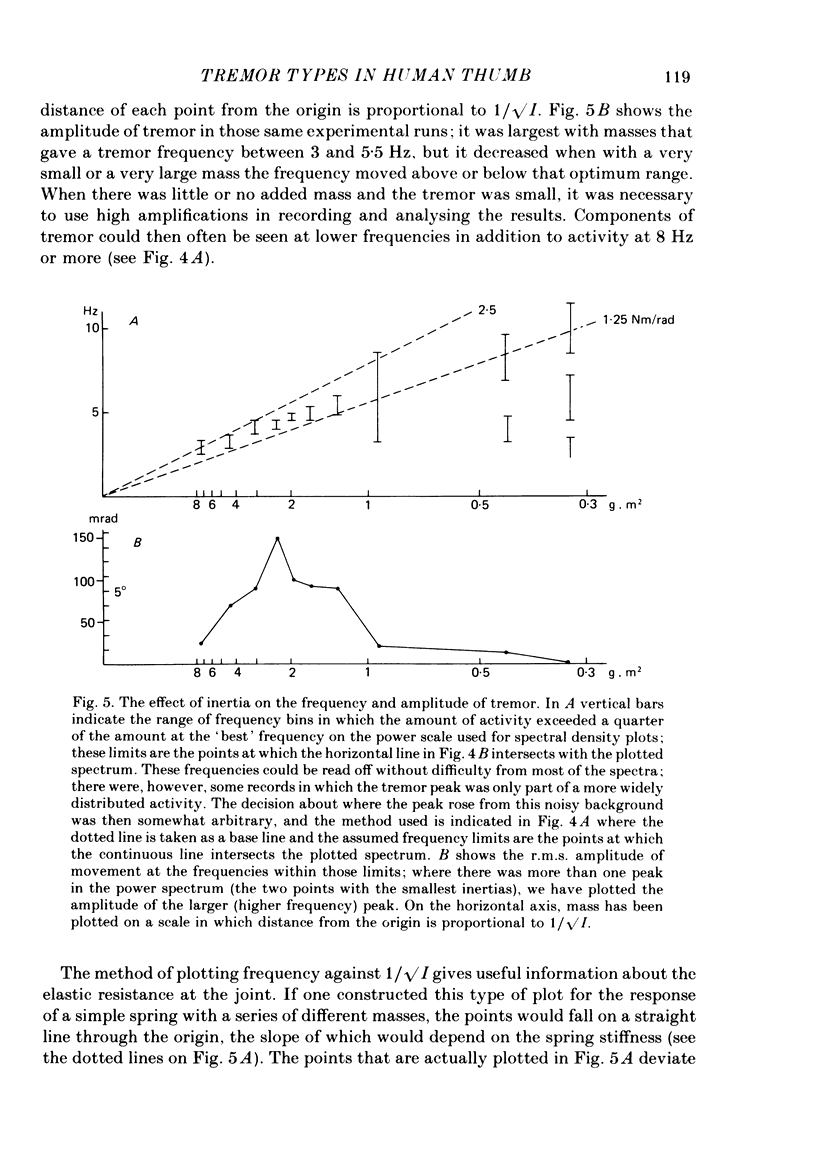
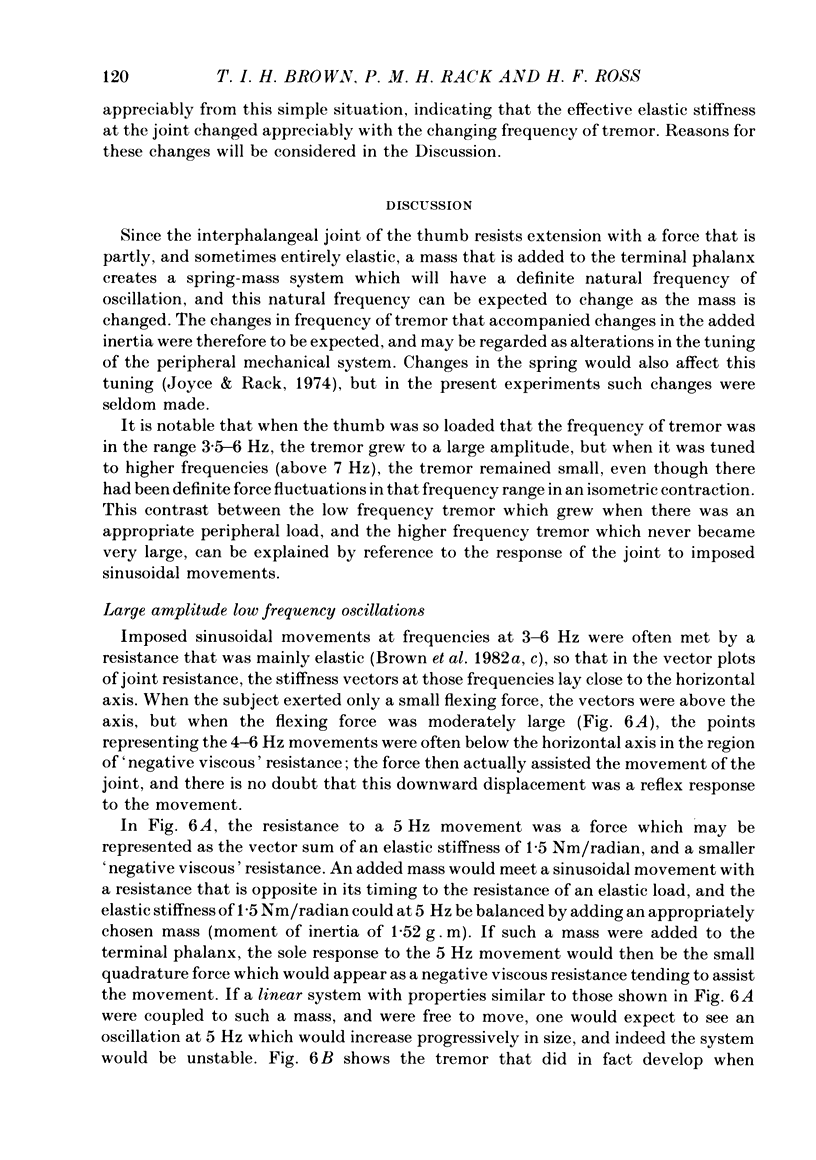
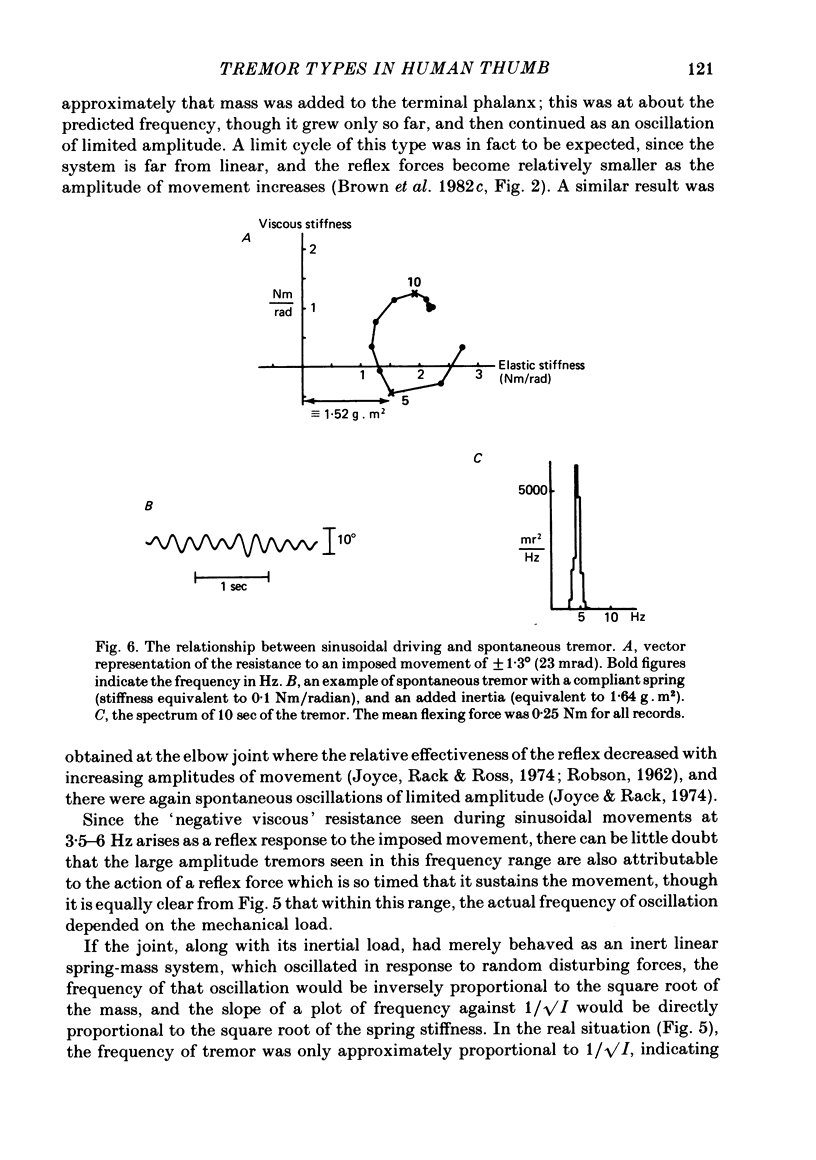
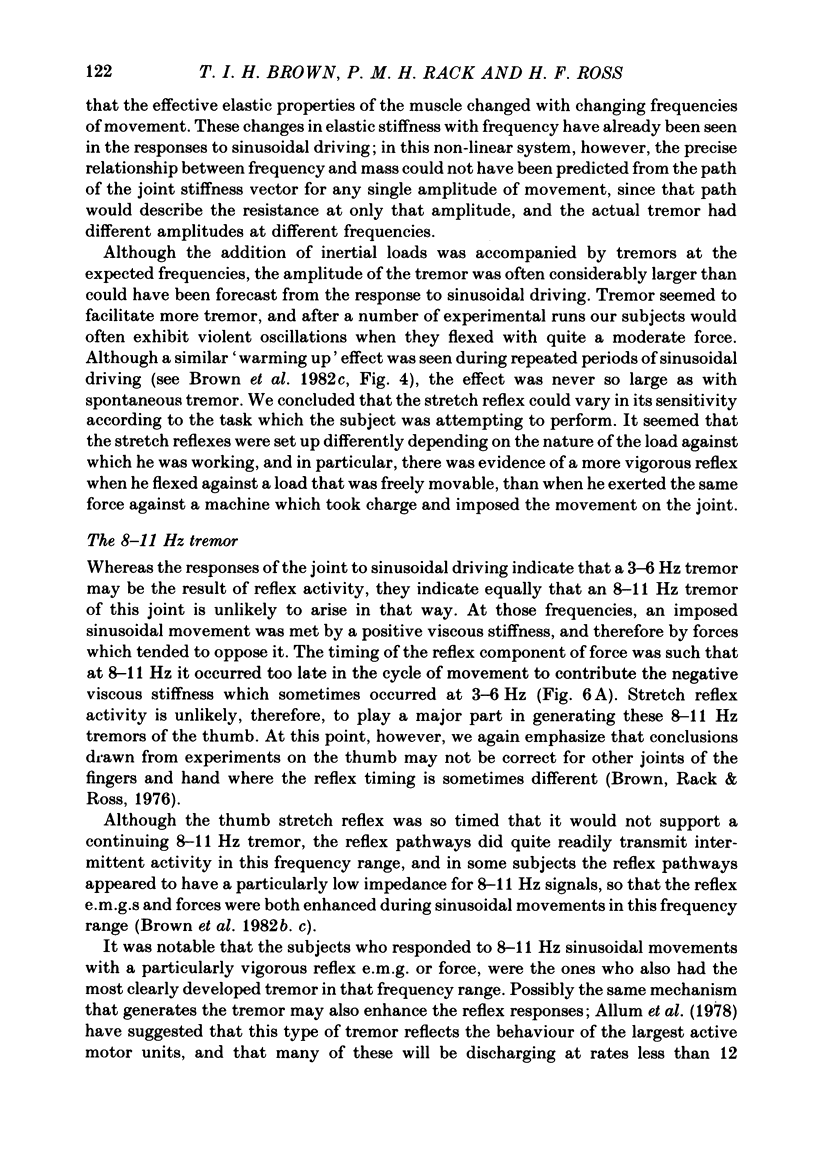
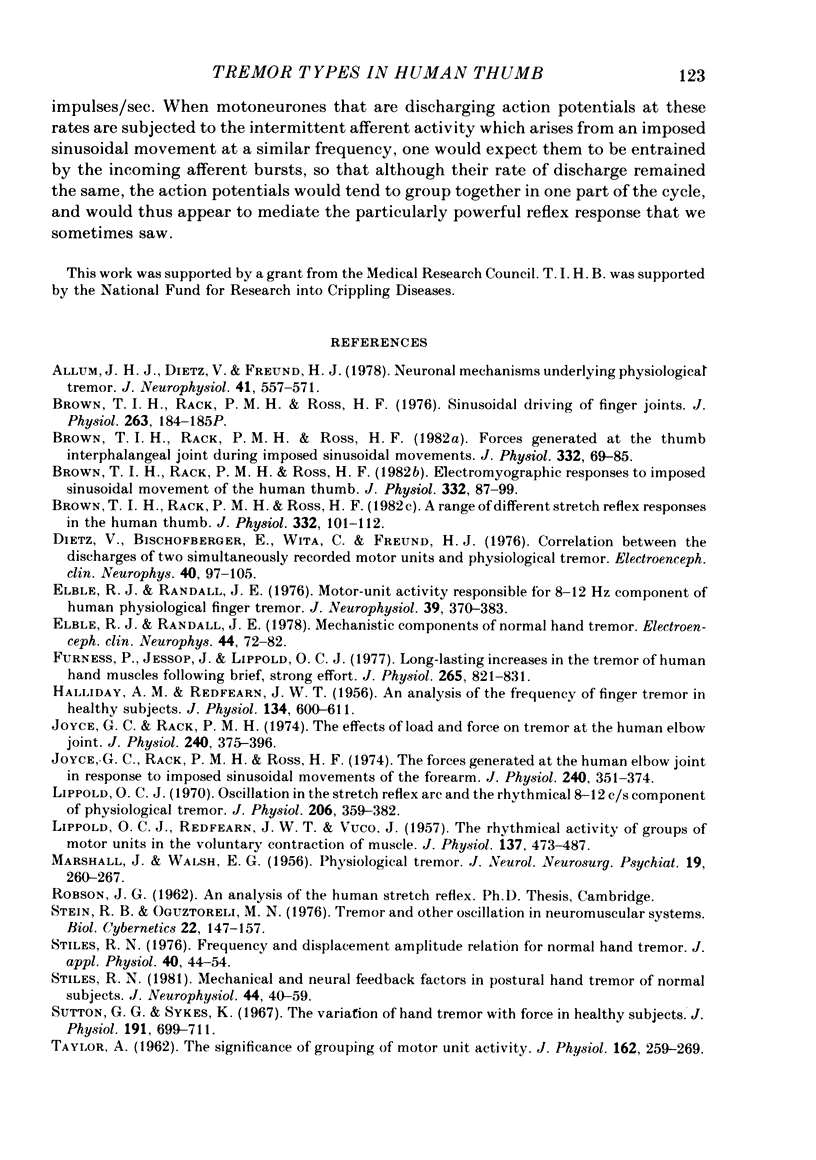
Selected References
These references are in PubMed. This may not be the complete list of references from this article.
- Allum J. H., Dietz V., Freund H. J. Neuronal mechanisms underlying physiological tremor. J Neurophysiol. 1978 May;41(3):557–571. doi: 10.1152/jn.1978.41.3.557. [DOI] [PubMed] [Google Scholar]
- Brown T. I., Rack P. M., Ross H. F. Electromyographic responses to imposed sinusoidal movement of the human thumb. J Physiol. 1982 Nov;332:87–99. doi: 10.1113/jphysiol.1982.sp014402. [DOI] [PMC free article] [PubMed] [Google Scholar]
- Brown T. I., Rack P. M., Ross H. F. Forces generated at the thumb interphalangeal joint during imposed sinusoidal movements. J Physiol. 1982 Nov;332:69–85. doi: 10.1113/jphysiol.1982.sp014401. [DOI] [PMC free article] [PubMed] [Google Scholar]
- Brown T. I., Rack P. M., Ross H. F. Sinusoidal driving of finger joints [proceedings]. J Physiol. 1976 Dec;263(1):184P–185P. [PubMed] [Google Scholar]
- Dietz V., Bischofberger E., Wita C., Freund H. J. Correlation between the dischanges of two simultaneously recorded motor units and physiological tremor. Electroencephalogr Clin Neurophysiol. 1976 Jan;40(1):97–105. doi: 10.1016/0013-4694(76)90183-8. [DOI] [PubMed] [Google Scholar]
- Elble R. J., Randall J. E. Mechanistic components of normal hand tremor. Electroencephalogr Clin Neurophysiol. 1978 Jan;44(1):72–82. doi: 10.1016/0013-4694(78)90106-2. [DOI] [PubMed] [Google Scholar]
- Elble R. J., Randall J. E. Motor-unit activity responsible for 8- to 12-Hz component of human physiological finger tremor. J Neurophysiol. 1976 Mar;39(2):370–383. doi: 10.1152/jn.1976.39.2.370. [DOI] [PubMed] [Google Scholar]
- Furness P., Jessop J., Lippold O. C. Long-lasting increases in the tremor of human hand muscles following brief, strong effort. J Physiol. 1977 Mar;265(3):821–831. doi: 10.1113/jphysiol.1977.sp011746. [DOI] [PMC free article] [PubMed] [Google Scholar]
- HALLIDAY A. M., REDFEARN J. W. An analysis of the frequencies of finger tremor in healthy subjects. J Physiol. 1956 Dec 28;134(3):600–611. doi: 10.1113/jphysiol.1956.sp005668. [DOI] [PMC free article] [PubMed] [Google Scholar]
- Joyce G. C., Rack P. M., Ross H. F. The forces generated at the human elbow joint in response to imposed sinusoidal movements of the forearm. J Physiol. 1974 Jul;240(2):351–374. doi: 10.1113/jphysiol.1974.sp010614. [DOI] [PMC free article] [PubMed] [Google Scholar]
- Joyce G. C., Rack P. M. The effects of load and force on tremor at the normal human elbow joint. J Physiol. 1974 Jul;240(2):375–396. doi: 10.1113/jphysiol.1974.sp010615. [DOI] [PMC free article] [PubMed] [Google Scholar]
- LIPPOLD O. C., REDFEARN J. W., VUCO J. The rhythmical activity of groups of motor units in the voluntary contraction of muscle. J Physiol. 1957 Aug 6;137(3):473–487. doi: 10.1113/jphysiol.1957.sp005828. [DOI] [PMC free article] [PubMed] [Google Scholar]
- Lippold O. C. Oscillation in the stretch reflex arc and the origin of the rhythmical, 8-12 C-S component of physiological tremor. J Physiol. 1970 Feb;206(2):359–382. doi: 10.1113/jphysiol.1970.sp009018. [DOI] [PMC free article] [PubMed] [Google Scholar]
- MARSHALL J., WALSH E. G. Physiological tremor. J Neurol Neurosurg Psychiatry. 1956 Nov;19(4):260–267. doi: 10.1136/jnnp.19.4.260. [DOI] [PMC free article] [PubMed] [Google Scholar]
- Stein R. B., Oğuztöreli M. N. Tremor and other oscillations in neuromuscular systems. Biol Cybern. 1976;22(3):147–157. doi: 10.1007/BF00365525. [DOI] [PubMed] [Google Scholar]
- Stiles R. N. Frequency and displacement amplitude relations for normal hand tremor. J Appl Physiol. 1976 Jan;40(1):44–54. doi: 10.1152/jappl.1976.40.1.44. [DOI] [PubMed] [Google Scholar]
- Stiles R. N. Mechanical and neural feedback factors in postural hand tremor of normal subjects. J Neurophysiol. 1980 Jul;44(1):40–59. doi: 10.1152/jn.1980.44.1.40. [DOI] [PubMed] [Google Scholar]
- Sutton G. G., Sykes K. The variation of hand tremor with force in healthy subjects. J Physiol. 1967 Aug;191(3):699–711. doi: 10.1113/jphysiol.1967.sp008276. [DOI] [PMC free article] [PubMed] [Google Scholar]
- TAYLOR A. The significance of grouping of motor unit activity. J Physiol. 1962 Jul;162:259–269. doi: 10.1113/jphysiol.1962.sp006930. [DOI] [PMC free article] [PubMed] [Google Scholar]


